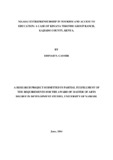| dc.description.abstract | The Maasai have embraced tourism entrepreneurship as a means to supplement and diversify
their sources of livelihood and spur development in their homelands. Access to education is one
of the indicators of development. The objectives of the study were: to determine the different
tourism entrepreneurial activities undertaken by Maasai households in Kimana; to analyze the
benefits that households derive from tourism entrepreneurship; and to examine how these
benefits have enhanced access to education. The study was guided by the community
entrepreneurial model and a conceptual framework developed for the research. The study was
conducted in Kimana group ranch which lies adjacent to Amboseli Nation Park in May 2015.
Both qualitative and quantitative data were collected using a closed and open ended
questionnaire and key informant interviews.
The study established that Maasai households were involved in a wide range of tourism
entrepreneurial activities including selling curios and handicrafts to tourists, tour
guiding/interpreting, beadworks, entertainment, selling Maasai shukas1 and as managers of their
own tourism enterprises from which they accrued various financial and non-financial benefits.
While many households in this study utilized significant amounts of income accrued from their
tourism entrepreneurial activities to purchase basic necessities and foodstuffs, a small but
critical amount was used to enhance access to education through paying for the cost of putting
up educational infrastructure, paying fees, hiring teachers and purchasing school supplies. It
was observed that the amount of benefits that households accrued from their tourism
entrepreneurship were low and this limited their capacity to commit more resources to
enhancing access to education.
The main conclusion from the study is that tourism entrepreneurship has the potential to
generate enormous benefits for the Maasai households but at the moment these benefits are
small and their contribution to enhancing access to education is minimal. The potential of
tourism entrepreneurship to enhance access to education depends on the amount of benefits
accrued, household priorities and decisions on how much money is to be spent on other
household pressing needs. The study suggests that if Maasai entrepreneurs in tourism generate
more benefits from their enterprises, households will increase their expenditures on enhancing
access education at the household level. The study recommended that in order for Maasai
households to increase their expenditures on enhancing access to education, they need to
maximize their benefits from tourism entrepreneurship. Therefore there is an urgent need for
household entrepreneurs to expand and diversify the range of tourism activities they undertake;
need for capacity building, education and training in business management, planning and
product development; need for the government to promote Maasai tourism attraction to increase
visitation in order to increase the direct benefits they derive from the industry.
Maasai shuka refers to a piece of fabric or garment made of cotton worn around the body by the Maasai. They are usually red although there are other colors | en_US |



